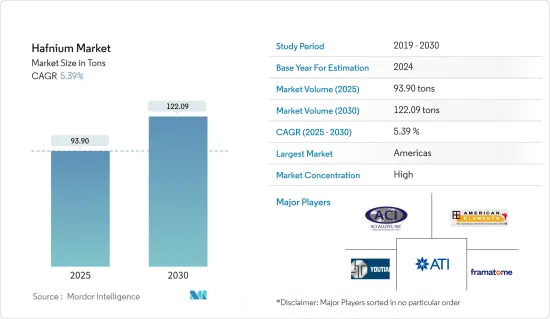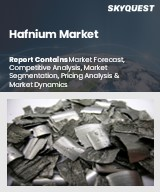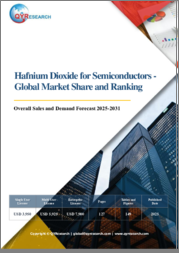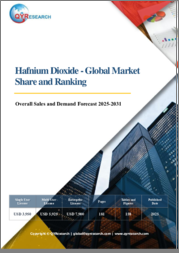
|
시장보고서
상품코드
1686551
하프늄 시장 : 시장 점유율 분석, 산업 동향 및 통계, 성장 예측(2025-2030년)Hafnium - Market Share Analysis, Industry Trends & Statistics, Growth Forecasts (2025 - 2030) |
||||||
하프늄 시장 규모는 2025년에 93.90톤으로 추계되고, 2030년에는 122.09톤에 달할 것으로 예측되며, 예측기간(2025-2030년)의 CAGR 5.39%를 나타낼 전망입니다.

주요 하이라이트
- COVID-19 팬데믹은 하프늄 시장에 부정적인 영향을 미쳤습니다. 생산 시설의 폐쇄와 잠시 중단으로 인해 여러 부문이 심각한 피해를 입어 하프늄 소비가 제한되었습니다. 그럼에도 불구하고 2020년 이후에도 주요 최종 사용자 범주에서 지속적인 노력으로 인해 시장은 천천히 발전했으며 앞으로도 그 길을 계속할 것으로 보입니다.
- 시장을 이끄는 주요 요인은 항공우주 산업에서의 하프늄 수요 증가와 반도체에서의 사용 증가입니다. 그러나 재료의 높은 가격은 시장 성장을 저해 할 가능성이 높습니다. 다양한 하프늄 제품에 대한 응용 기반이 증가함에 따라 예측 기간 동안 수많은 성장 기회가 제공 될 것으로 예상됩니다.
- 중국은 전 세계 시장을 지배 할 것으로 예상됩니다. 그러나 유럽은 세계에서 가장 빠르게 성장하는 지역으로 간주됩니다.
하프늄 시장 동향
시장을 독점하는 초합금 용도
- 하프늄은 주로 초합금으로 사용되며, 이 용도가 전체 하프늄 사용량의 50% 이상을 차지합니다. 하프늄은 초고온에서 작동할 때 높은 강도와 안정성으로 인해 항공 우주 및 산업용 터빈의 응용 분야에 초합금으로 사용됩니다.
- 하프늄 초합금은 주로 제트 엔진과 로켓 엔진에서 발견됩니다. 하프늄은 로켓 엔진 노즐에 사용되는 니오븀 기반 합금의 약 10%를 차지합니다. 하프늄은 MAR M 247 초합금에서 필수 불가결한 것으로 간주되며 제트 엔진의 뜨거운 부분(터빈 블레이드 및 베인)에 사용됩니다.
- 하프늄 초합금은 주로 전기 생산에 사용되는 산업용 터빈에 사용될 가능성이 있습니다. 따라서 발전 산업과 풍력 에너지 발전의 성장 추세는 하프늄 초합금의 성장에 유리하게 작용할 것입니다.
- 국제에너지기구(IEA) 통계에 따르면 세계 발전량은 2022년에도 계속 성장해 전년대비 2.4% 증가(약 700TWh)로 지난 5년간 관찰된 CAGR과 거의 동일합니다. 2022년 세계 석탄 화력 발전량은 약 2%(185 TWh) 증가했습니다. 발전원으로서의 석탄은 2년 연속 증가하여 발전량은 1만 테라와트시(TWh)를 넘어 총 발전량의 36%를 차지했습니다. 또한 IEA의 예측에 따르면 석탄 발전 설비 용량은 2025년까지 세계에서 약 2,319GW에 달하고, 2022년 2,271GW에서 증가합니다.
- 중국은 1,390개의 섬으로 구성된 중국 최대 열도의 전력 수요를 충당하기 위해 1.7기가와트(GW)의 전기를 석탄 화력보다 배출량이 적은 대체 에너지로 설치할 계획을 발표했습니다.
- 2023년 10월 - GE 베르노바의 가스 파워 사업부와 하얼빈 일렉트릭은 오늘 중국 국가개발투자공사(Chinese State Development & Investment Corp. (SDIC)의 진엉(저우산) 가스 발전 유한회사가 저우산 군도에 위치한 이 발전소에 GE 9HA.02 가스 터빈 2기를 주문했다고 발표했습니다.
- 2022년 5월, J-Power USA Development Co. Ltd. (J-POWER USA)는 미국 일리노이주 엘우드에 위치한 1,200메가와트(MW) 복합 사이클 발전소인 잭슨 발전 프로젝트에서 북미 최초로 미쓰비시 파워 M501JAC 가스 터빈 2기를 상업 운전하는 데 성공했습니다.
- 다양한 산업에서 초합금의 중요성이 높아짐에 따라 하프늄 시장에 대한 수요는 예측 기간 동안 증가할 것으로 예상됩니다.
아시아태평양을 지배하는 중국
- 중국에서 하프늄은 원자로, 항공기, 산업용 터빈 및 기타 산업에서 스펀지, 합금 및 기타 형태로 사용됩니다. 하프늄은 중성자 포집 단면적과 중성자 흡수 능력이 강하기 때문에 원자로에서 제어봉을 만드는 데 사용됩니다.
- 중국의 가동 가능한 원자력 발전 용량은 2022년에 52,000메가와트 이상에 달했습니다. 같은 해 중국은 미국과 프랑스에 이어 전 세계에서 세 번째로 큰 원자력 발전 용량을 보유하게 되었습니다.
- 중국 원자력 협회에 따르면 원자력은 2035년까지 중국 내 전력 생산량의 약 10%, 2060년까지 18%를 차지할 것으로 예상됩니다.
- 2022년 9월, 중국은 115억 달러 규모의 원자력 발전소 2기를 승인하여 2022년 중국이 승인한 원자력 발전소 10기의 목록을 완성했습니다. 이 발전소들은 중국의 극심한 전력 부족 상황을 해결하고 하프늄 소비를 촉진할 것으로 기대됩니다.
- 2023년 8월, 당국은 3개 발전소에 추가로 6기의 원자력 발전소 건설을 승인하여 작년에 승인된 원자력 발전 프로젝트는 총 10기입니다. 새로운 원자력 프로젝트는 예측 기간 동안 원자로에 사용되는 제어봉에 대한 하프늄 수요를 유발할 것으로 예상됩니다.
- 산화하프늄은 광학 코팅과 DRAM 커패시터 및 첨단 금속 산화물 반도체 소자의 고 유전체로 사용됩니다. 중국은 반도체 칩의 순 수입국이며, 중국은 사용되는 반도체의 20% 미만을 제조합니다. 그러나 광범위한 수요 시나리오의 이점을 누리기 위해 중국 정부는 2030년까지 3,050억 달러의 생산량을 달성하여 국내 수요의 80%를 충족하겠다는 목표를 발표한 '중국 제조 2025' 계획과 같은 전략적 이니셔티브에 착수했습니다.
- 중국 기업들은 반도체 산업에 진출하기 위한 노력을 강화하고 있습니다. 중국 정부는 다양한 정책적 인센티브를 통해 반도체 기업이 공장을 건설할 수 있도록 보조금을 지급하고 있습니다. 반도체 생산 시설 계획을 발표한 도시로는 충칭, 상하이, 베이징, 청두, 허페이, 선전, 우한, 샤먼, 랴오닝, 산시성 등이 있습니다.
- 따라서 반도체 제조시설의 신설에 따라 산화하프늄 수요는 예측기간 동안 급속히 증가할 것으로 예상됩니다.
- 중국은 또한 주요 항공기 제조업체 중 하나이며 국내 최대 항공 여객 시장 중 하나입니다. 또한 중국의 항공 부품 및 조립 제조 부문은 빠르게 확장되고 있으며, 200개 이상의 소규모 항공기 부품 제조업체가 존재합니다.
- 보잉 상용 전망(2022-2041년)에 따르면 2041년까지 약 8,485대의 신규 납품이 이루어지고 시장 서비스 가치는 5,450억 달러에 달할 것으로 예상됩니다. 이러한 신규 납품으로 인해 하프늄에 대한 수요도 증가할 것으로 보입니다.
- 앞서 언급한 모든 요인은 국내 하프늄 소비를 증가시킬 것으로 예상됩니다.
하프늄 산업 개요
세계의 하프늄 시장은 고도로 통합되어 있으며 주요 기업 2개사가 하프늄 금속의 생산과 공급의 70% 이상을 차지하고 있습니다. 시장의 주요 기업(특정한 순서 없음)에는 Framatome(EDF), American Elements, Nanjing Youtian Metal Technology, ATI, ACI Alloys 등이 있습니다.
기타 혜택
- 엑셀 형식 시장 예측(ME) 시트
- 3개월간의 애널리스트 지원
목차
제1장 서론
- 조사의 성과
- 조사의 전제
- 조사 범위
제2장 조사 방법
제3장 주요 요약
제4장 시장 역학
- 성장 촉진요인
- 항공우주 산업의 수요 증가
- 반도체에서 하프늄 기반 재료의 활용도 증가
- 억제요인
- 높은 가격과 분리 및 추출의 어려움
- 기타 억제요인
- 산업 밸류체인 분석
- Porter's Five Forces 분석
- 공급기업의 협상력
- 소비자의 협상력
- 신규 참가업체의 위협
- 대체품의 위협
- 경쟁도
- 가격 분석
제5장 시장 세분화
- 유형
- 산화하프늄
- 탄화하프늄
- 기타 유형(금속하프늄 포함)
- 용도
- 초합금
- 광학 코팅
- 원자력
- 플라즈마 절단
- 기타 용도
- 지역
- 생산 분석
- 프랑스
- 미국
- 중국
- 세계 기타 지역
- 소비 분석
- 미국
- 유럽연합
- 러시아
- 중국
- 인도
- 일본
- 세계 기타 지역
- 생산 분석
제6장 경쟁 구도
- M&A, 합작사업, 제휴, 협정
- 시장 점유율 분석
- 주요 기업의 전략
- 기업 프로파일
- ACI Alloys
- Alkane Resources Ltd
- American Elements
- Baoji ChuangXin Metal Materials Co. Ltd(CXMET)
- 중국 Nulear JingHuan Zirconium Industry Co. Ltd.
- Framatome(EDF)
- Nanjing Youtian Metal Technology Co. Ltd
- Phelly Materials Inc.
- Starfire Systems Inc.
제7장 시장 기회와 앞으로의 동향
- 재사용 가능한 우주선에 대한 관심 증가
- 방사선 치료용 산화 하프늄 나노 입자 연구 확대
The Hafnium Market size is estimated at 93.90 tons in 2025, and is expected to reach 122.09 tons by 2030, at a CAGR of 5.39% during the forecast period (2025-2030).

Key Highlights
- The COVID-19 pandemic negatively impacted the hafnium market. Due to the lockdown and brief halts in production facilities, several applications suffered significant damage, limiting hafnium consumption. Nonetheless, beyond 2020, the market developed slowly due to ongoing efforts in the main end-user categories and is likely to continue on its path.
- Major factors driving the market are the rising demand for hafnium in the aerospace industry and its increasing usage in semiconductors. However, higher prices of the material will likely hinder the market growth. The increasing application base for various hafnium products is anticipated to provide numerous growth opportunities over the forecast period.
- China is expected to dominate the market across the world. However, Europe is considered to be the fastest-growing region in the world.
Hafnium Market Trends
Super Alloys Application to Dominate the Market
- Hafnium is majorly used as a superalloy, and this application accounts for more than 50% of the total usage of hafnium. Due to its high strength and stability when operating at very high temperatures, hafnium is used as a superalloy for applications in aerospace and industrial turbines.
- Hafnium superalloys are mostly found in jet and rocket engines. Hafnium makes up roughly 10% of the niobium-based alloy used in rocket engine nozzles. It is regarded as indispensable in the MAR M 247 superalloy and is used in the hot section of jet engines (turbine blades and vanes).
- Hafnium superalloys are potentially used in industrial turbines, which are majorly used to produce electricity. Hence, the growing trends in the power generation industry and wind energy generation will favor the growth of hafnium superalloys.
- According to the International Energy Agency (IEA) statistics, global electricity generation continued to grow in 2022, increasing by 2.4% (nearly 700 TWh) year-over-year, which is similar to the average annual growth observed over the previous 5 years. In 2022, Global coal-fired electricity generation rose by nearly 2% (185 TWh). Coal as a source for electricity generation increased for the second year in a row, generating more than 10,000 Terawatt-hour (TWh), accounting for 36% of total generation. Moreover, according to the IEA forecasts, the installed coal power generation capacity will reach around 2,319 GW by 2025 globally, an increase from 2,271 GW in 2022.
- China has announced plans to install 1.7 gigawatts (GW) of electricity to power demand for China's largest archipelago, comprised of 1390 islands, with lower emissions than coal-fired alternatives. In October 2023 - GE Vernova's Gas Power business and Harbin Electric today announced that Chinese State Development & Investment Corp., Ltd. (SDIC) Jineng (Zhoushan) Gas Power Generation Co., Ltd. ordered two GE 9HA.02 gas turbines this power plant located in the Zhoushan archipelago.
- In May 2022, J-Power USA Development Co. Ltd. (J-POWER USA) achieved commercial operation with the first two Mitsubishi Power M501JAC gas turbines manufactured in North America at its Jackson generation project, a 1,200 megawatt (MW) combined-cycle power plant in Elwood, Illinois, United States.
- Owing to the rising importance of superalloys in various industries, the demand for the hafnium market is expected to grow during the forecast period.
China to Dominate the Asia-Pacific Region
- In China, hafnium is used in nuclear reactors, aircraft, industrial turbines, and other industries in the form of sponges, alloys, and other forms. Hafnium is used in nuclear reactors to make control rods due to its strong neutron-capture cross-section and neutron-absorbing capabilities.
- China's operable nuclear power capacity reached over 52,000 megawatts of electrical in 2022. In the same year, China had the third-largest operable nuclear power capacity worldwide after the United States and France.
- Nuclear power is expected to contribute about 10% of power generation in the country by 2035 and 18% by 2060, as per China's Nuclear Energy Association.
- In September 2022, China approved two nuclear plants worth USD 11.5 billion, completing the list of 10 nuclear power units sanctioned by the country in 2022. The power plants are expected to sort out the country's crippling power shortage condition and trigger higher consumption of hafnium.
- In August 2023, authorities approved an additional six nuclear power units to be built at three plants, totaling ten nuclear power projects approved last year. New nuclear projects are expected to induce demand for hafnium for control rods used in the reactors in the forecast period.
- Hafnium oxide finds application in optical coatings and as a high dielectric in DRAM capacitors and advanced metal oxide semiconductor devices. China is the net importer of semiconductor chips, with China manufacturing less than 20% of semiconductors used. However, to benefit from the extensive demand scenario, China has embarked on strategic initiatives, like the Made in China 2025 plan, under which the Chinese government has announced its goal to reach an output of USD 305 billion by 2030 and, therefore, meet 80% of its domestic demand.
- The Chinese companies are stepping up efforts to push into the semiconductor industry. The Chinese government has subsidized semiconductor companies to build factories through various policy incentives. Some cities that have announced their plans for semiconductor production facilities include Chongqing, Shanghai, Beijing, Chengdu, Hefei, Shenzhen, Wuhan, Xiamen and Liaoning, and Shaanxi.
- Therefore, with the establishment of new semiconductor manufacturing facilities, the demand for hafnium oxide is expected to increase rapidly over the forecast period.
- China is also one of the leading aircraft manufacturers and one of the largest domestic air passenger markets. Furthermore, the country's aviation parts and assembly manufacturing sector has been quickly expanding, with over 200 minor aircraft parts manufacturers present.
- According to the Boeing Commercial Outlook 2022-2041, around 8,485 new deliveries will be made by 2041 with a market service value of USD 545 billion. The demand for hafnium will likely rise due to such new deliveries in the country.
- All the aforementioned factors, in turn, are expected to augment the consumption of hafnium in the country.
Hafnium Industry Overview
The global hafnium market is highly consolidated, with the top two players accounting for more than 70% of the production and supply of hafnium metal. Some of the market's major players (not in any particular order) include Framatome (EDF), American Elements, Nanjing Youtian Metal Technology Co. Ltd., ATI, and ACI Alloys, among others.
Additional Benefits:
- The market estimate (ME) sheet in Excel format
- 3 months of analyst support
TABLE OF CONTENTS
1 INTRODUCTION
- 1.1 Study Deliverables
- 1.2 Study Assumptions
- 1.3 Scope of the Study
2 RESEARCH METHODOLOGY
3 EXECUTIVE SUMMARY
4 MARKET DYNAMICS
- 4.1 Drivers
- 4.1.1 Rising Demand from the Aerospace Industry
- 4.1.2 Increasing Utilization of Hafnium-Based Materials in Semiconductors
- 4.2 Restraints
- 4.2.1 Higher Prices and Difficulties in Seperation and Extraction
- 4.2.2 Other Restraints
- 4.3 Industry Value Chain Analysis
- 4.4 Porter's Five Forces Analysis
- 4.4.1 Bargaining Power of Suppliers
- 4.4.2 Bargaining Power of Consumers
- 4.4.3 Threat of New Entrants
- 4.4.4 Threat of Substitute Products and Services
- 4.4.5 Degree of Competition
- 4.5 Price Analysis
5 MARKET SEGMENTATION (Market Size in Volume)
- 5.1 Type
- 5.1.1 Hafnium Oxide
- 5.1.2 Hafnium Carbide
- 5.1.3 Other Types (including Hafnium Metal)
- 5.2 Application
- 5.2.1 Super Alloy
- 5.2.2 Optical Coating
- 5.2.3 Nuclear
- 5.2.4 Plasma Cutting
- 5.2.5 Other Applications
- 5.3 Geography
- 5.3.1 Production Analysis
- 5.3.1.1 France
- 5.3.1.2 United States
- 5.3.1.3 China
- 5.3.1.4 Rest of the World
- 5.3.2 Consumption Analysis
- 5.3.2.1 United States
- 5.3.2.2 European Union
- 5.3.2.3 Russia
- 5.3.2.4 China
- 5.3.2.5 India
- 5.3.2.6 Japan
- 5.3.2.7 Rest of the World
- 5.3.1 Production Analysis
6 COMPETITIVE LANDSCAPE
- 6.1 Mergers and Acquisitions, Joint Ventures, Collaborations, and Agreements
- 6.2 Market Share Analysis
- 6.3 Strategies Adopted by Leading Players
- 6.4 Company Profiles
- 6.4.1 ACI Alloys
- 6.4.2 Alkane Resources Ltd
- 6.4.3 American Elements
- 6.4.4 Baoji ChuangXin Metal Materials Co. Ltd (CXMET)
- 6.4.5 China Nulear JingHuan Zirconium Industry Co. Ltd.
- 6.4.6 Framatome (EDF)
- 6.4.7 Nanjing Youtian Metal Technology Co. Ltd
- 6.4.8 Phelly Materials Inc.
- 6.4.9 Starfire Systems Inc.
7 MARKET OPPORTUNITIES AND FUTURE TRENDS
- 7.1 Growing Inclination on Reusable Spacecrafts
- 7.2 Growing Research on Hafnium Oxide Nanoparticles for Radiotherapy



















